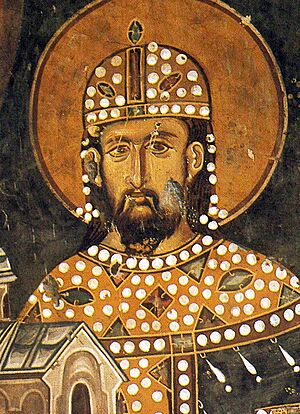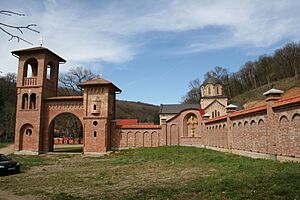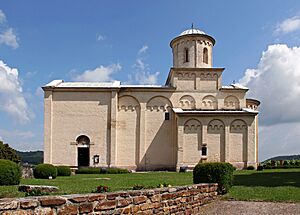Stefan Dragutin facts for kids
Quick facts for kids SaintStefan Dragutin Стефан Драгутин |
|
|---|---|
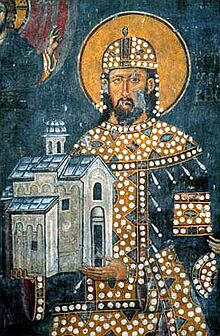
King Dragutin, founder's portrait (fresco) in Saint Achillius Church, painted during his lifetime (around 1296)
|
|
| Stefan the Teoktist | |
| Born | c. 1244 |
| Died | March 1316 |
| Venerated in | Eastern Orthodox Church |
Stefan Dragutin (Serbian Cyrillic: Стефан Драгутин, Hungarian: Dragutin István; born around 1244 – died March 12, 1316) was a medieval Serbian ruler. He was the King of Serbia from 1276 to 1282. After 1282, he ruled a separate kingdom in northern Serbia. This kingdom also included some Hungarian border areas from 1284. Because of this, people sometimes called him "King of Syrmia."
Dragutin was the oldest son of King Stefan Uroš I of Serbia and Queen Helen. He married Catherine of Hungary. This marriage likely happened after his father made peace with Catherine's grandfather, Béla IV of Hungary, in 1268. By 1271, Dragutin was called "young king." This title showed he had the right to become king after his father. He later rebelled against his father. With help from Hungary, he forced his father to step down in 1276.
Dragutin changed his father's way of ruling. He gave large areas of land to his mother to rule. In 1282, Dragutin had a riding accident and broke his leg. Because of this, he decided to give up his throne to his brother, Milutin. However, Dragutin kept control of the northern parts of Serbia near the Hungarian border. Two years later, his brother-in-law, Ladislaus IV of Hungary, gave him three more areas: Mačva, Usora, and Soli. Dragutin was the first Serbian king to rule Belgrade. With his brother's help, he also took control of the Banate of Braničevo around 1284 or 1285.
In theory, Dragutin was a vassal (a ruler who owes loyalty to another ruler) to both his brother (for his Serbian lands) and the Hungarian kings (for the four Hungarian areas). But in reality, he ruled his kingdom like an independent ruler from the 1290s. His disagreements with Milutin led to a war in 1301. He also often attacked Hungarian lords from 1307. Many Serbian noblemen supported Dragutin. However, he had to make peace with Milutin after Milutin's hired soldiers defeated him around 1311 or 1312. Before he died, Dragutin became a monk. He took the name Theoctistus. He is honored as a saint in the Eastern Orthodox Church on November 12 or October 30.
Contents
Early Life of Stefan Dragutin
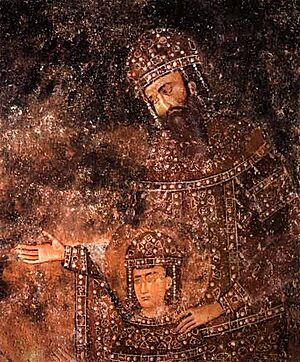
Stefan Dragutin was the older son of King Stefan Uroš I of Serbia and Helen of Anjou. We don't know exactly when or where he was born. A monk named Domentijan wrote in 1264 that the "fourth generation" of Stefan Nemanja's family was old enough to ride horses and carry spears. This likely meant Dragutin. Historian Miodrag Purković believes Dragutin was about 20 years old then, so he was probably born around 1244.
The exact date of Dragutin's marriage to Catherine of Hungary is also unknown. His father and Catherine's grandfather, Béla IV of Hungary, likely arranged the marriage. This happened during peace talks after Uroš I attacked Mačva in 1268. Mačva was a Hungarian border area north of Serbia. Uroš I raided the area but was captured. He then had to make peace.
Catherine's father, Stephen V, was called "younger king" as his father's co-ruler. Dragutin received the same title. This showed his special right to inherit Serbia from his father. The Peace of Pressburg in 1271 is the first document that calls Dragutin a "younger king."
Later, Archbishop Danilo II wrote that Dragutin's Hungarian relatives expected Uroš to give some land to Dragutin. This would let Dragutin rule those areas on his own. Some historians think the peace agreement might have said Serbia should be divided between Uroš I and Dragutin. But Uroš had spent years making his government stronger. He did not want to divide his kingdom with his son. Dragutin and his wife lived at his father's court in the late 1260s.
In 1276, Dragutin rebelled against his father. We don't know if he wanted his father to share power. Or if he feared his younger brother, Milutin, would become king instead. Dragutin's brother-in-law, Ladislaus IV of Hungary, sent Hungarian and Cuman soldiers to help him. Dragutin defeated his father near Gacko in the autumn of 1276. Uroš gave up his throne without fighting more. He went to the Sopoćani Monastery and died there a year later.
Stefan Dragutin's Rule
King of Serbia
After Uroš I lost his throne, the archbishop of Serbia, Joanikije I, also stepped down. This might have been a protest against Dragutin taking the throne. Or he might have been forced to leave because he was close to the old king. Soon after becoming king, Dragutin gave large parts of Serbia to his mother. These areas included Zeta, Trebinje, other coastal lands, and Plav. These lands became a special area for the Serbian royal family's heirs after his mother died. Milutin went with their mother to her lands and lived in Shkodër.
Serbia's relationship with the Republic of Ragusa had been difficult during Uroš I's last years. But Dragutin made peace with Ragusa soon after he became king. Charles I of Anjou, the King of Sicily, wanted Dragutin to join a group against the Byzantine Empire. The two kings wrote letters about this in 1279.
In early 1282, Dragutin fell off his horse and broke his leg. His injury was very serious. A meeting was held in Deževo to decide how to rule Serbia. At this meeting, Dragutin gave up his throne to Milutin. But the reasons for this are not fully clear. Years later, Dragutin said he was already having problems with Milutin. He claimed he only gave the government to Milutin temporarily, until he got better. Archbishop Danilo II wrote that Dragutin gave up the throne because he saw the accident as God's punishment for what he did to his father. But the Archbishop also mentioned other "serious troubles" that led to Dragutin's choice. A Byzantine historian, George Pachymeres, wrote that Dragutin's decision to step down was final. But Pachymeres also mentioned an agreement. This agreement said that Dragutin's son would become king after Milutin.
Ruler of Syrmia
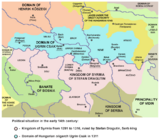
Even after giving up the throne, Dragutin was still called "king." But Milutin was clearly the main ruler. Dragutin still used the title of king in his official papers and on his coins. Frescoes in St. Achillius Church show both Dragutin and Milutin wearing royal symbols. This church was built by Dragutin near Arilje. But Dragutin is shown with fewer royal symbols. When Dragutin gave up the throne, Serbia was divided between him and Milutin. Dragutin kept the northern area near the Hungarian border. This included the new silver mine at Rudnik. He also had lands in western Serbia along the Lim River. This made him his brother's most powerful vassal.
Ladislaus IV of Hungary gave Mačva, Usora, and Soli to Dragutin in 1284. Relatives of the Hungarian kings had ruled these areas before. Dragutin continued to rule them as a Hungarian vassal. Mačva was also known as Sirmia ulterior. So, people often called Dragutin "King of Srem." He made his main home at Debrc on the Sava River. But he also often stayed in Belgrade. He was the first Serbian king to rule Belgrade.
Dragutin ruled his lands independently from his brother. He supported the Franciscans' religious work in Bosnia. He also allowed a Catholic church leader to be set up in Belgrade. Two Cuman or Bulgarian warlords, Darman and Kudelin, had taken over a former Hungarian area called the Banate of Braničevo. Dragutin invaded Braničevo with Hungarian help in 1284 or 1285. But he could not defeat them. Darman and Kudelin hired Cuman and Tatar soldiers. They started raiding Dragutin's lands.
Dragutin asked Milutin for help. The two brothers met in Mačkovac. They joined their armies and defeated Darman and Kudelin. Dragutin then took Braničevo in 1291 or 1292. The new Hungarian king, Andrew III, also supported their military action. But Andrew's weak position in Hungary allowed Dragutin to become more independent.
Dragutin's sister-in-law, Mary, claimed the Hungarian throne after her brother Ladislaus IV died. Dragutin was said to support her and her son, Charles Martel of Anjou. Charles Martel believed he was the rightful king of Hungary. In 1292, he gave Slavonia to Dragutin's son, Vladislav. But most Hungarian noblemen stayed loyal to Andrew III. Dragutin also tried to make peace with Andrew. Vladislav married Constance, the granddaughter of Andrew's uncle, Albertino Morosini, in 1293. Dragutin took advantage of Hungary's problems in the late 1200s. He became one of the powerful lords who ruled large areas without much control from the king.
Dragutin supported his brother's attacks on Byzantine lands in Macedonia in the 1290s. Milutin made peace with the Byzantine Empire in 1299. After this, many Serbian noblemen who had gained from the war moved to Dragutin's kingdom. Problems between the two brothers grew quickly. This was probably because Milutin wanted his own sons to become kings of Serbia. In 1301, a war broke out. Milutin took Rudnik from Dragutin. Reports from Ragusa say a peace treaty was made in late 1302. But Dragutin's troops or allies robbed Milutin's silver mines at Brskovo in 1303. The fighting lasted for more than ten years, but we don't know all the details. The brothers supposedly avoided big battles. Dragutin kept his kingdom almost complete. However, Milutin used money from his silver mines to hire soldiers.
Charles Martel's son, Charles Robert, came to Hungary in 1300 to claim the throne. His grandfather, Charles II of Naples, listed Dragutin and his wife as Charles Robert's main supporters. From 1301 to 1304, Charles Robert spent much time in the lands of the powerful Ugrin Csák. These lands were north of Dragutin's kingdom. This suggests Charles Robert and Dragutin had a good relationship. For unknown reasons, Dragutin's troops attacked Csák's lands in 1307. But Csák fought back and defeated Dragutin's army before October 13, 1307.
Dragutin made an alliance with Charles Robert's opponent, Ladislaus III Kán, who ruled Transylvania. Dragutin's Orthodox son married Kán's daughter. Because of this, the Pope's representative, Gentile Portino da Montefiore, removed Kán from the church in late 1309. Historian Alexandar Krstić suggests Dragutin wanted his older son, Vladislav, to be King of Hungary. He wanted his younger son, Urošica, to be King of Serbia. Records show the damage Dragutin and his troops caused in Valkó and Szerém Counties. This likely refers to Dragutin's frequent raids against Ugrin Csák's lands in 1309 and 1310. His ally John Smaragd led Dragutin's army. But Paul I Garai, Ugrin's commander, defeated him. Dragutin also took property from the Archbishopric of Kalocsa. This stopped the new Archbishop Demetrius from visiting Rome until late 1312.
His conflict with Charles Robert forced him to fight on two sides. He could continue the war against his brother because Serbian noblemen rebelled against Milutin in the early 1310s. The Serbian church leaders stayed loyal to Milutin. They helped him hire Tatar, Jassic, and Turkish soldiers. Milutin decisively defeated Dragutin in late 1311 or 1312. The church leaders then helped arrange a peace treaty between them, likely in 1312. Dragutin had to accept his brother as the rightful king. But his Serbian lands (including the silver mine at Rubnik) were fully returned to him. Dragutin sent soldiers to help his brother fight the powerful Ban of Croatia, Mladen II Šubić of Bribir, in 1313. According to Krstić, Dragutin probably made a peace treaty with Charles Robert in Sremska Mitrovica in February 1314. In 1314 or 1316, Dragutin signed his brother's document for the Banjska Monastery as "the former king."
Dragutin became a monk and took the name Teoctist shortly before he died. According to Archbishop Danilo II's writings, Dragutin said he could not be honored as a saint while he was dying. He died on March 12, 1316. He was buried in the Đurđevi Stupovi Monastery. He is seen as the second founder of this monastery, which his great-grandfather, Stephen Nemanja, had built. On the list of Serbian saints, Dragutin is honored on November 12 or October 30. His son, Stefan Vladislav II, took over his northern lands.
Sources
|
Stefan Dragutin
Died: 12 March 1316 |
||
| Regnal titles | ||
|---|---|---|
| Preceded by Uroš I |
King of Serbia 1276–1282 |
Succeeded by Milutin |
| Preceded by new title |
King of Syrmia 1282–1316 |
Succeeded by Vladislav |


